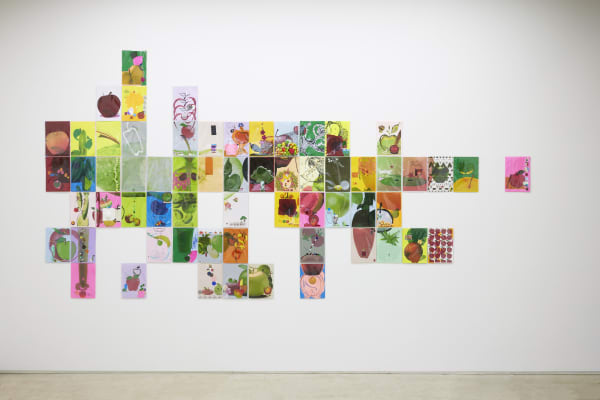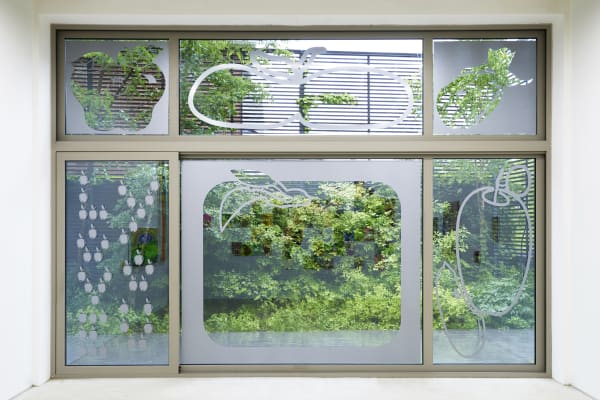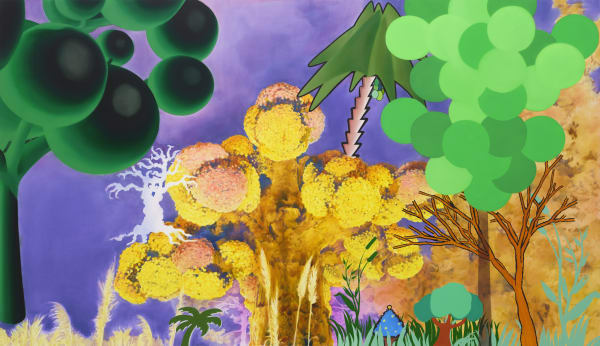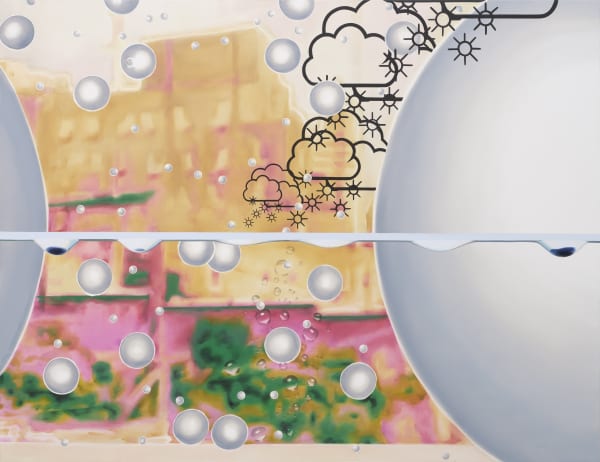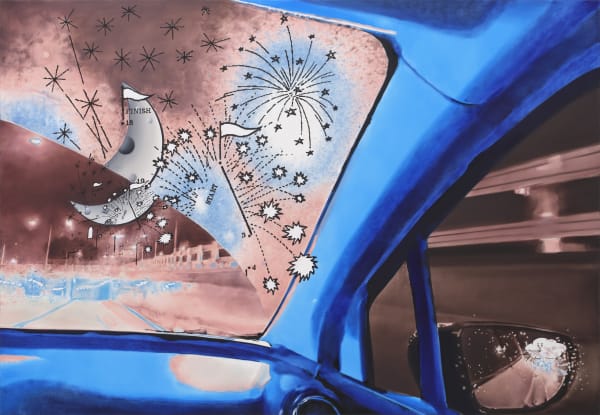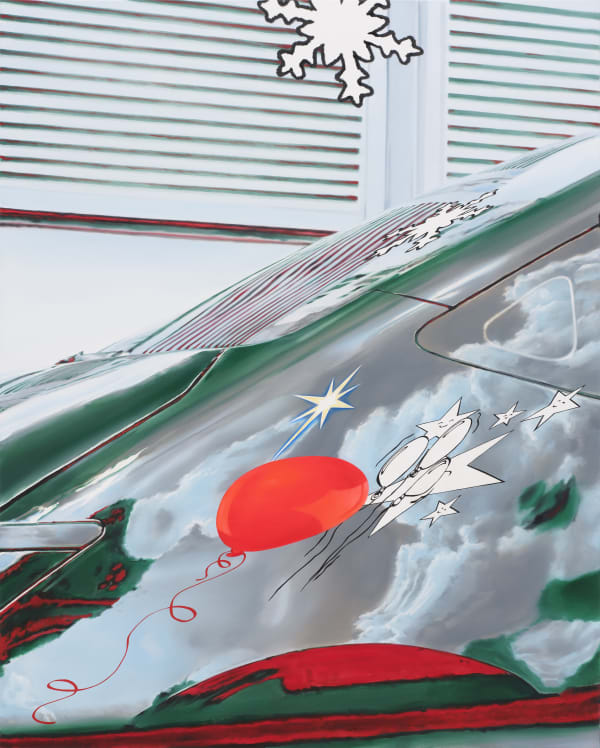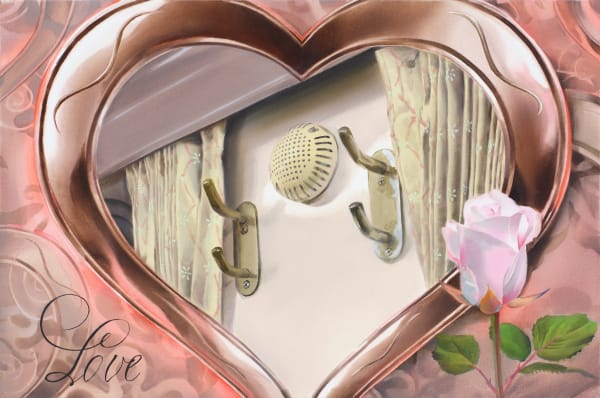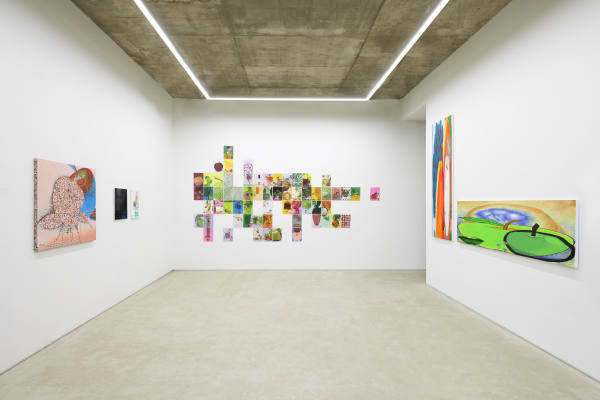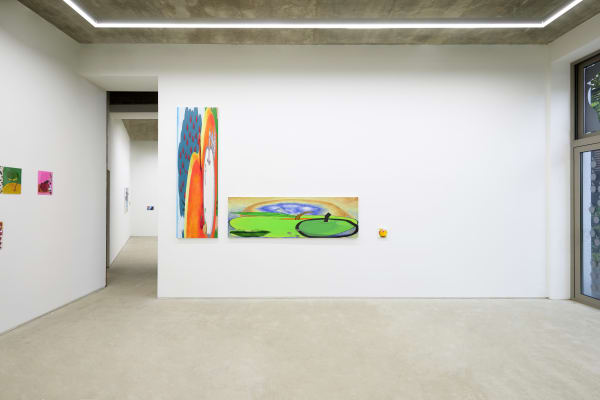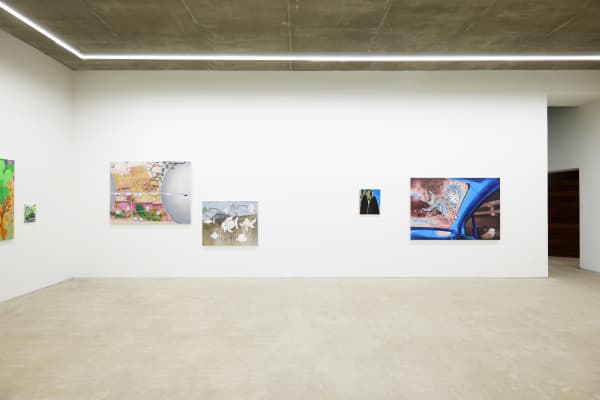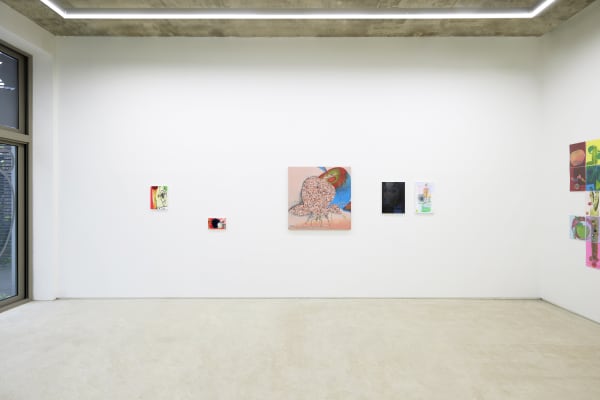Juice up: 윤영빈 Yeongbin Yoon
눈에 비친 세계를 의심할 수 있다면. 이 세계가 표면만 보여주고 있음을 깨닫는다면. 봄의 문제에서 보는 이의 자리가 사실 보여진 것의 자리였다면. 윤영빈은 풍부한 첨단 기술과 실용적 가치가 득세하는 현실 뒤편에 어설프고 열악한 것으로 남은 회화가 할 일을 생각한다. 직사각형에 적당한 크기와 두께를 가진 테크놀로지의 집약체는 빛을 후면에서 발산하고 화면을 작은 점으로 나누며 모든 상(像)이 선명해지도록 유도한다. 반면 회화는 물감과 붓을 도구 삼아 움직이는 화가의 손으로 그려지며 하염없이 흐려질 뿐인 화면을 유지한다. 여기서 우리가 보는 것이 사실 세계의 일부이고 그 일부란 개별 대상이 모여 이룬 군의 어떤 평평한 표면임을 상상할 때, 그리기의 과정은 회화가 첨단 기술보다 부족한 것이 아니라 회화 그 자체의 일을 하고 있음을 상기시켜 준다. 세계가 보여주는 표면을 회화로 넘겨 올 때, 반드시 무언가 누락된다. 어떤 의도건 그것을 빗나갈 수밖에 없는 구조. 역설적이게도 여전히 회화가 믿음직한 이유다.
《Juice up》에서 윤영빈은 고정된 표면을 직시하는 태도를 취함으로써 보여진 세계를 흉내낸다. 그는 표면으로 맺힌 세계를 하나의 풍경이라 인식하고, 풍경의 요소를 회화의 영역에 불러온다. 그에게 보이는 풍경은 개별 대상의 합으로 구성되며, 그는 각각의 요소에 점을 찍거나 순서를 매겨 잇는 방식으로 대상의 위치를 파악한다. 예를 들어 나뭇잎과 줄기에서 시작해 그 너머의 나무, 숲, 하늘이 드러나고, 자동차 안의 창틀을 본 후 창밖의 사이드미러, 철골 다리, 달과 별이 나타나는 식이다. 이러한 과정은 그가 세계를 인식하는 방식에서 완결된 구성의 화면으로서 풍경보다는 풍경을 구성하기 위해 세워진 화면의 세부 요소를 파악하는 일이 선행된다는 사실을 암시한다. 또한 그 암시에는 화가의 상상을 앞지를 만큼(혹은 상상을 시작하기조차 어렵게 할 만큼) 과잉생산된 이미지에 대한 자신의 소회가 담겨 있다. 넘쳐나는 이미지의 나열에서 그는 “떠날 수 없는 마을에 갇혀 세계를 보는 방식을 학습 당하는” 듯한 곤경에 처한다(작가 노트, 2024). 무언가를 보려 할수록 동일한 상황을 마주할 뿐. 특정한 대상을 선택해 왜곡, 장식 등의 편집을 시도하거나 대상 간의 관계를 파악하고 의미를 부여할 여지가 없이, 그에게는 구성을 위한 구조를 체결받기 전 준비 단계에 놓인 개별 대상만이 쉼 없이 다가올 뿐이다. 보이는 대상의 수가 불어날수록 그가 할 수 있는 일은 대상이 가진 그대로의 모습을 회화로 옮겨오는 것에 머무른다. 그것이 자신이 세계를 본 방식이고, 세계가 자신에게 보여진 방식이기 때문이다.
윤영빈에게 대상의 모습을 그대로 그리는 것, 즉 재현의 의미는 이미지를 회화로 옮기는 과정에서 일어나는 누락을 인정하는 일로부터 발생한다. 달리 말해, 그는 온전한 재현을 달성하는 것이 아니라 닮음에 다가가는 여정에서 나타나는 물러남의 순간을 누적하여 재현의 근처를 배회하려 한다. 윤영빈은 보여진 대상의 표면을 낱장의 이미지로 여기고 이를 물감으로 모방한다. 이때 현실의 대상이 가진 특징과 회화의 표현을 거쳐 구현된 특징 사이의 격차를 최대한 줄이고자 애쓴다. 이를 위해 그는 촘촘하고 반드러운 극세목 캔버스와 고품질 상품으로서의 가치를 내세운 제조사의 물감을 선택하고, 물감을 얇게 펼쳐 붓의 궤적을 지우는 붓질을 활용한다. 또는 어떤 이미지의 주제, 형태를 파악하기에 적합하거나 특정 이미지에서 자연스럽게 연상되는 이미지를 근처에 배치한다. 물감을 쌓고 말리고 굳히기를 반복해 그리기의 과정을 가려가며 만든 윤곽, 서로를 방해하지 않고 명확히 구획된 이미지는 각 이미지가 지닌 본래의 특징을 강조한다. 마치 제작자의 주관성을 소거한 공산품처럼 그의 회화는 군더더기 없이 매끄러워지는 것이다. 그런데 이렇게 직조된 이미지는, 결코 기존의 이미지가 될 수 없다. 광원도, 시점도 어색한 화면이 편재한다. 이미지를 닮으려는 이미지는 가까워지는 과정의 중첩을 통해 결국 서로 간에 거리가 있음을 변증법적으로 입증한다. 여기서 재현을 향한 열의가 의도적으로 들키게 되고, 이 모순적인 순간에 비로소 회화가 지닌 고유의 세계가 나타난다.
전시 제목인 ‘Juice up’은 ‘활력을 불어넣는다’는 의미다. 이곳에 놓인 회화에는 윤영빈이 세계를 인식하는 방식과 동일한 양상으로 구현된 이미지가 조합되어 있다. 휴대전화로 촬영한 사진, 클립아트나 포토 프레임과 같은 오픈 소스 이미지, 스티커, 포장지, 장식품 등은 각각의 원형을 모방해 만들어진 한편, 아무리 모방해도 원형에 다가갈 수 없는 결함을 동반한다. 특히 그가 클립아트 웹사이트에서 찾아 그린 사과 이미지의 모음은 진정한 사과의 자리만 비우는 ‘척’을 하며 그들만의 유형을 생성하고, 이로써 남겨진 사과의 자리를 상상하게 한다. 그렇게 《Juice up》은 세계가 윤영빈에게 보여지는 방식과 대상이 세계를 반영하는 방식을 중첩한다. 결합할수록 본래의 세계와 가까워지고, 동시에 멀어지는 이미지들. “언젠가 끝에 닿아 새로운 곳으로 떨어질 수 있기를 희망하며,” 윤영빈의 회화에서 이미지들은 충돌하고 협력한다(작가 노트, 2024).
Doubt reality as it appears before our very eyes; come to recognize our perception of reality as being only surface-level; understand that in seeing, the observer occupies the position of the observed—Yoon Yeongbin contemplates the role of painting today, amidst all the advanced tools, technology, and practical values that seem to render paint crude and inadequate. These technological marvels come in ever-thinner rectangles with curved edges, emitting light on one or more sides in increasingly sophisticated ways through tiny pixels for clearer, crisper consumption of what is to be seen. Painting, however, relies solely on brushstrokes guided by the artist's hand, where each picture element can quickly become a blurred smudge on canvas.
What we see is indeed only a part of the world, a surface created by an aggregate of individual objects. This reminds us that painting should not be compared with technological advancements, as it performs and fulfils its own unique task. When something from reality’s surface is brought onto canvas, something is inevitably omitted, regardless of intent. This inherent omission paradoxically makes painting trustworthy.
Yoon Yeongbin’s Juice Up is a mimicry of the observed world, directly confronting the fixed surfaces of reality. Yoon perceives reality as a thin, crystallized surface structure that forms a landscape, bringing elements of that landscape into the realm of painting. The landscape she sees exists as a collection of separate objects. Each fragmented object she marks with dots or connects through some order or arrangement. For example, starting from the leaf and stem, the tree, forest, and sky are revealed; looking at the window frame inside a car, the side mirror, steel bridge, moon, and stars come into view.
This process implies that her perception of the world begins with grasping pictorial details intended to compose a landscape, rather than perceiving the landscape as a complete, composed picture. Implicit in this approach is her aversion to the excessive production of images that overwhelm the painter's imagination (or become such an obstacle that the painter is rendered incapable of any imagination at all). Such excess “forces me into a position not unlike being incarcerated in a town to be indoctrinated with a certain prescription for perspective” (artist's note, 2024). The greater the effort to see, the more she encounters more of the same. There is no margin left to select an object to distort or to adorn. There is no room to grasp at relationships between objects and to assign them meaning. There is only an endless stream of individual objects in a state of pre-meaning, awaiting structure and composition. As the number of seen objects grows, all she can do is transpose them to painting as they are. That is how Yoon saw the world, and that is how the world was revealed to her.
For Yoon Yeongbin, the meaning of representation, or painting an object as it is, begins with acknowledging the omissions that occur in the process of transposing an image onto canvas. It is not her aim to achieve complete representation but rather to linger near-representation by accumulating moments of withdrawal on the journey toward representation. Yoon considers the surface of the seen object as a single image and imitates it with paint—a process she places a great deal of effort to reduce the gap between the features of the actual object and its features realized through painting.
To do this, she chooses canvases with dense and smooth microfibers and selects high-quality paints that spread thinly without leaving brush marks. At times she places an image nearby that is appropriate to capture the subject matter, form, or natural evocation of a particular image. The contours created to obscure the drawing process, layered, dried, and setting the paint—the clearly compartmentalized images that do not interfere with each other—emphasize the original properties of each image. These choices strip her paintings of individuality and subjectivity, making them appear as if they were standardized factory-fabricated products. Yet these woven images will never be the original, as they are rife with awkward lighting compositions and inconsistent perspectives. The superimposition of resemblance-seeking processes of images becomes a dialectical demonstration of the inevitable distance between the images. Here, the eagerness for representation becomes deliberately exposed, and it is only in this moment of contradiction that a unique painterly world emerges.
The exhibition title Juice Up was chosen to mean “to invigorate." The paintings here combine images realized in the same manner as Yoon Yeongbin's perception of the world. Photos taken on a phone, clip art, open-source images like photo frames, stickers, packaging, and ornaments are created to imitate their originals. However, no amount of imitation can wholly replicate the originals. Particularly, her collection of apple images found on clip art websites only feigns the presence of true apples, generating their own types and prompting the imagination of the real apples’ absence. Thus, Juice Up overlaps the way the world appears to Yoon Yeongbin and the manner in which objects reflect the world. The more these images merge, the closer—and simultaneously further—they get from the actual, original world. The images clash and cooperate “in hopes of one day reaching an end, to finally fall into someplace new” (artist's note, 2024).
